This is the first of several posts which will show that climate change is becoming a real and present danger.
Climate Central has a graph showing the hottest 10 years on the record:
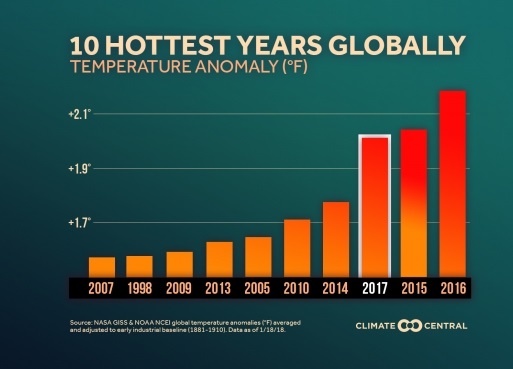
Nine of the hottest 10 years have been since 2005, with only 1998, the super-El Niño year included. That is based on the NOAA record which has 2017 the third hottest. I usually follow NASA which I think includes a better estimate of the polar regions. NASA has 2017 narrowly as the second hottest.
What is worrying the life out of some scientists is that 2017 was a neutral ENSO year, whereas 2015 and 2016 were both El Niño years. Here’s a graph with the trendlines for El Niño, neutral and La Niña years:
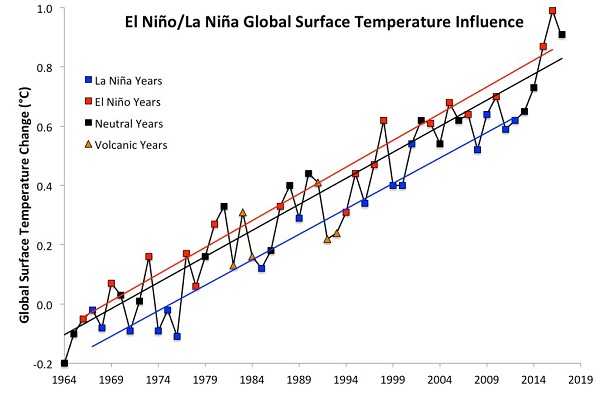
Dana Nuccitelli points out that 2017 beat the previous hottest non-El Niño year by a whopping 0.17°C, which is about the same as the decadal rise between 1964 and 2017.
James Hansen has taken a look. Here is his chart expressed as a 12-month running mean, with a 132 (11 year) running mean and the best linear fit:
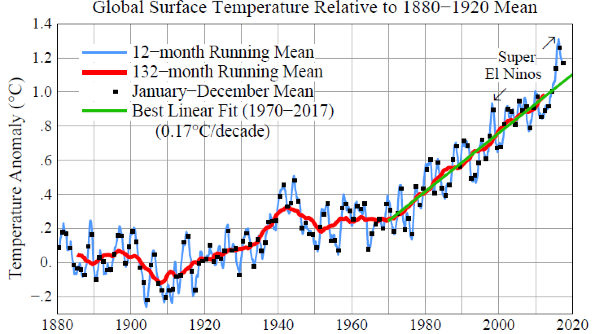
Hansen says that 2015 and 2017 are a virtual tie, with the difference inconsequential. This comment is important:
- Prospects for continued global temperature change are more interesting and important. The record 2016 temperature was abetted by the effects of both a strong El Niño and maximum warming from the solar irradiance cycle (Fig. 4). Because of the ocean thermal inertia and decadal irradiance change, the peak warming and cooling effects of solar maximum and minimum are delayed about two years after irradiance extrema. The amplitude of the solar irradiance variation is smaller than the planetary energy imbalance, which has grown to about +0.75 ± 0.25 W/m2 over the past several decades due to increasing atmospheric greenhouse gases.[5],[6] However, the solar variability is not negligible in comparison with the energy imbalance that drives global temperature change. Therefore, because of the combination of the strong 2016 El Niño and the phase of the solar cycle, it is plausible, if not likely, that the next 10 years of global temperature change will leave an impression of a ‘global warming hiatus’.
So we may have a ‘pause’ similar to what appeared immediately after the 1998 super-El Niño outcome, but 2017 is way above what happened in 1999 and 2000 in trend terms. The worry is that we have accelerating greenhouse emissions growth and polar climate feedbacks may accelerate. Hansen says the next few years will be of extreme interest.
Here’s the graph of CO2 from Mauna Loa measured in November 2017:
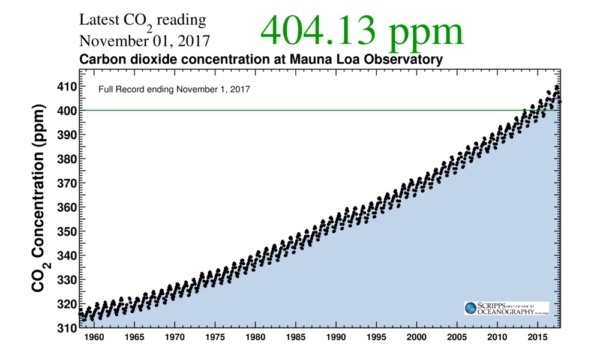
Tamino at Open Mind reckons it looks like a quadratic curve:
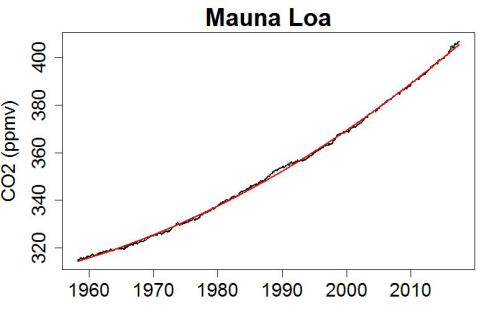
Carbon Brief shows 2017 as the warmest ever for the oceans with this graph of ocean heat content:
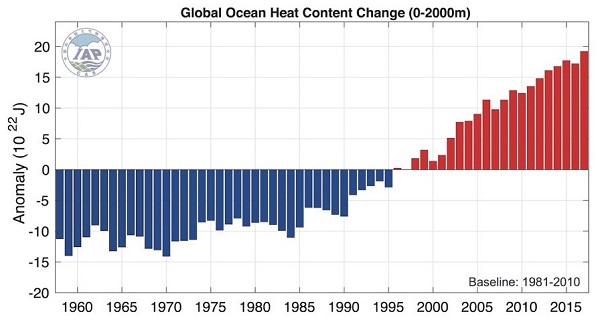
It’s looking ugly.
Finally, there is this charming scientific judgement by Gavin Foster and colleagues in an article Future climate forcing potentially without precedent in the last 420 million years. This is from the abstract:
- Humanity’s fossil-fuel use, if unabated, risks taking us, by the middle of the twenty-first century, to values of CO2 not seen since the early Eocene (50 million years ago). If CO2 continues to rise further into the twenty-third century, then the associated large increase in radiative forcing, and how the Earth system would respond, would likely be without geological precedent in the last half a billion years.
In the face of that I’m speechless, but if I’m spared for a few more days I’ll take a look at what is coming down the road.
Update: The WMO has a different graph which also distinguishes years according to ENSO:
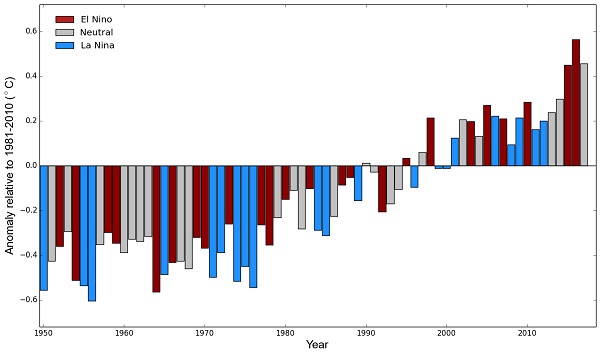
As is commonly done, they use the 1981-2010 average as the baseline. They have also classified 2017 as a neutral year, although the text says that it began and ended with a weak La Niña.
The article also has a clear world map of 2017 warming:
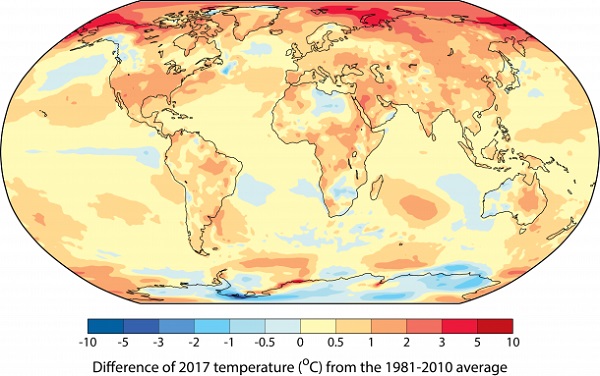
As expected the most intense warming is around the North Pole. The cool blob below Greenland is still there.
Update: Just a reminder of last year’s post Record 2016 heat spells trouble on global scale, which began:
- The third record year in a row has been declared. The last time it was as hot as this was 115,000 years ago. The last time CO2 was this high was in the Pliocene, 3 to 5 million years ago when the temperature became roughly 3 to 4 degrees Celsius warmer than today, and the sea level up to 40 metres higher.
Andrew Simms for The Guardian polled a number of scientists about whether we could keep warming under 2°C. Not a single one thought we would. One scientist said “not a cat in hell’s chance”. Kevin Anderson, now professor in Uppsala, said politically we gave up years ago. Prof Joachim Schellnhuber, director of the Potsdam Institute for Climate Impact Research, would “only confirm that it is still possible to keep global warming below 2C”. Technically speaking, I assume.

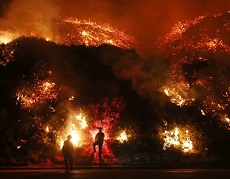
I’ve updated the post with some information from the WMO.
The CO2 trend shows no sign of any slow down.
Then there is the impact of the CO2 level itself on the health of the planet, particularly marine life.
Stephen colbert on Trump Climate “policy”
Liar, Liar, Planet on Fire!!
Stephen colbert on Trump Climate “policy”
Liar, Liar, Planet on Fire!!
__________________________________________________
Now, between the time the global temperature increase starts its irreversible runaway – and – when the last of us is cooked, there will be plenty of time to hunt down the culprits and punish them. So, will the Nuremberg Defence work for us then?
GB: Most of the coal eaters are old enough that they will probably be dead before the climate trials start. That is, assuming that the world will still be organized enough despite all the rising crisis to organize trials
Unfortunately, John, you make a serious comment!
I’ve just updated the post with a link to the equivalent post last year Record 2016 heat spells trouble on global scale, which began:
The third record year in a row has been declared. The last time it was as hot as this was 115,000 years ago. The last time CO2 was this high was in the Pliocene, 3 to 5 million years ago when the temperature became roughly 3 to 4 degrees Celsius warmer than today, and the sea level up to 40 metres higher.
Andrew Simms for The Guardian polled a number of scientists about whether we could keep warming under 2°C. Not a single one thought we would. One scientist said “not a cat in hell’s chance”. Kevin Anderson, now professor in Uppsala, said politically we gave up years ago. Prof Joachim Schellnhuber, director of the Potsdam Institute for Climate Impact Research, would “only confirm that it is still possible to keep global warming below 2C”. Technically speaking, I assume.
I do what I to reduce my own consumption of fossil fuels but, living as I do in a deliberately-depressed rural area with fewer and fewer services, I cannot avoid going into the big smoke. Ride sharing does help but what I save is only a
nanofemto-coal-train or less.Still each of us still needs to try being frugal with non-renewable energy.
Graham I was shocked in 2008 when we went to Europe for the first time in 2008. Rivers of people from the time we got off the plane in Zurich. Going down the Rhine Germany seemed to hum with boats, trains and cars. Just masses everywhere. Seemed like a few strays had run away to Oz.